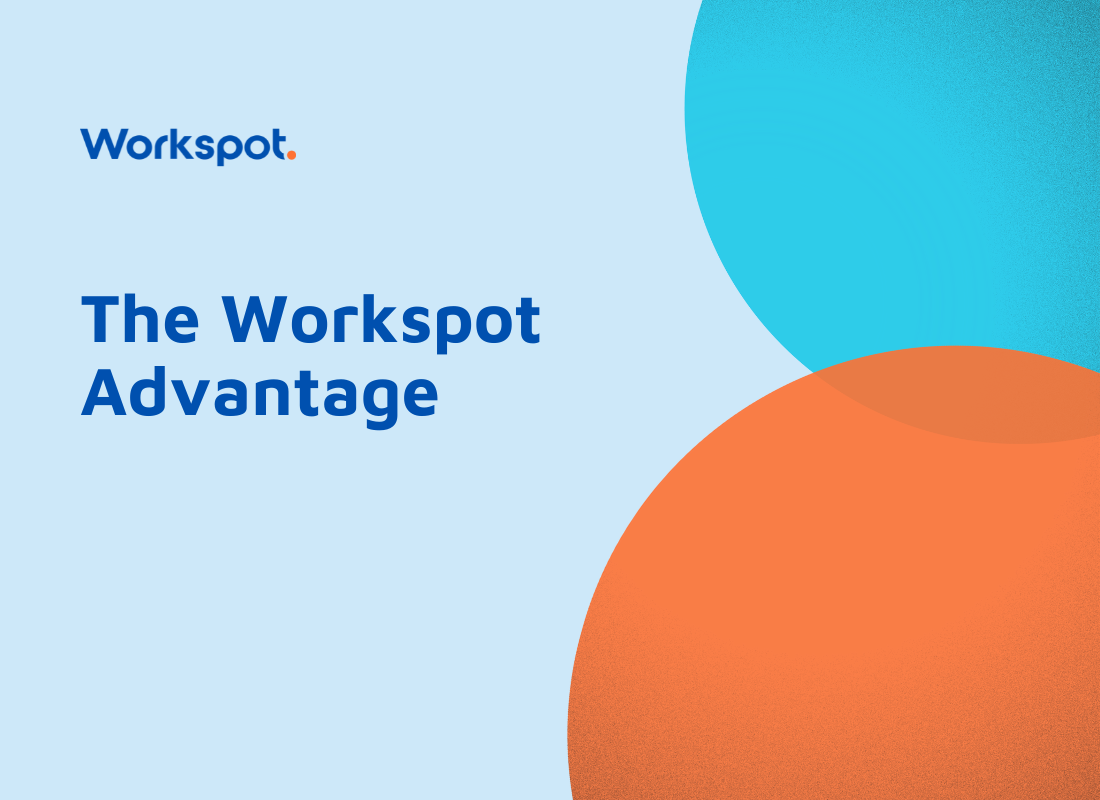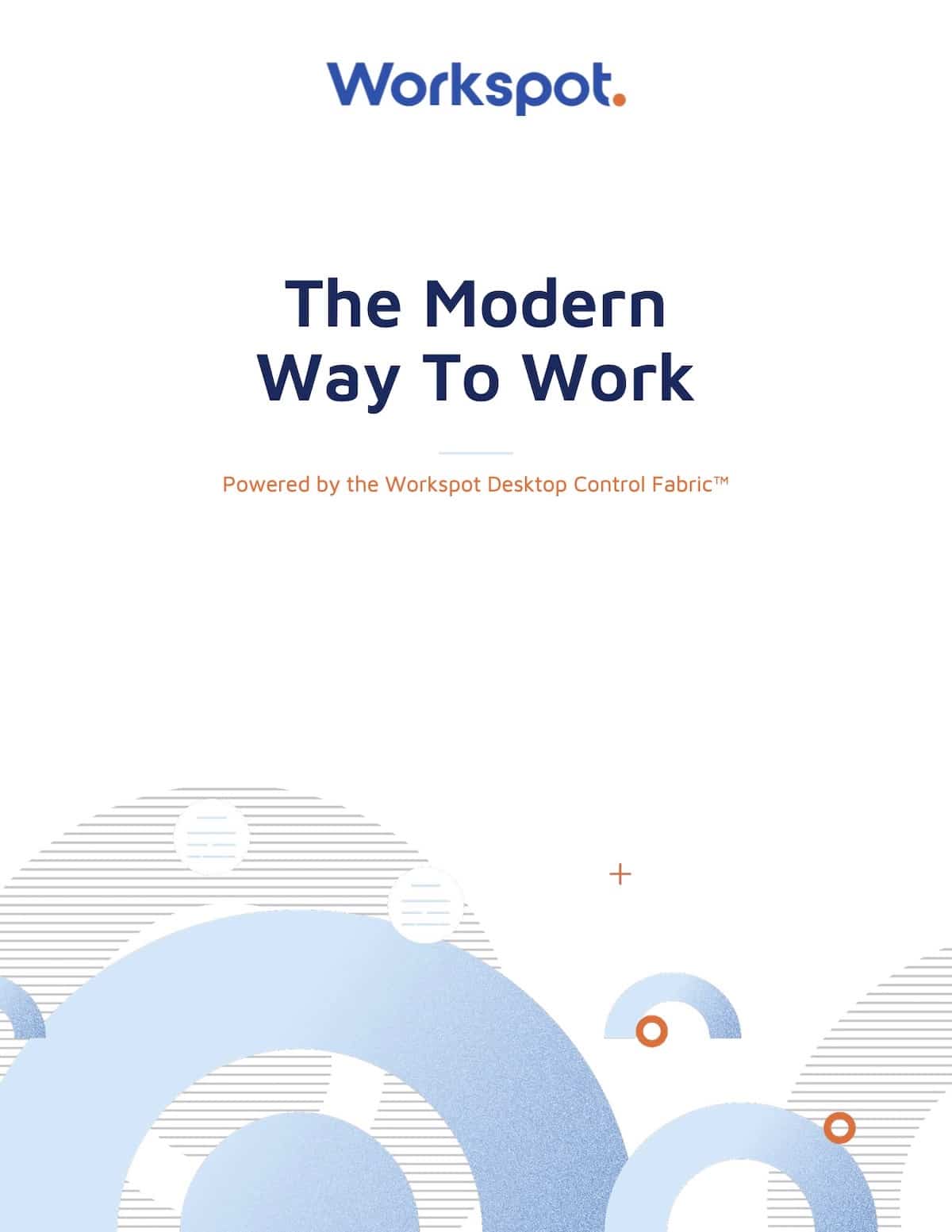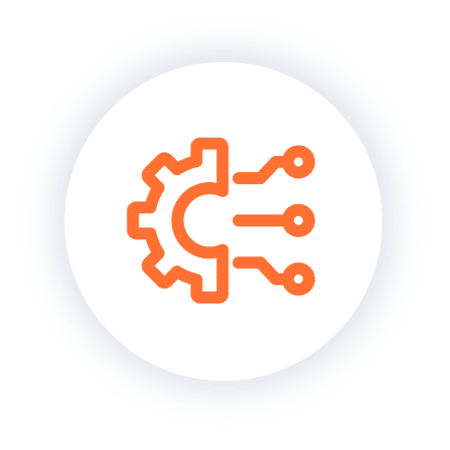The Modern
Way To Work
Powered by the Workspot Desktop Control Fabric™
Executive Summary
Enterprise IT organizations have been struggling with the cost and complexity of provisioning Windows PCs for decades. Buying, imaging, shipping, patching, securing, refreshing, and repairing physical Windows machines has been a necessary — and often immense — cost of doing business. The problem becomes even more severe with distributed organizations, where a single unpatched PC puts the entire organization at security risk, and a far-flung workforce further challenges provisioning and break/fix processes.
Organizations have tried to solve this challenge in several ways with varying degrees of success. Management tools such as SCCM and its more recent derivatives have emerged to improve patching and updates. Service providers and OEMs, including Dell and IBM have stepped in with PC as a Service offerings. Many organizations centralized Windows using legacy VDI to simplify patching, albeit often generating new costs, creating more complexity, and degrading the user experience. Other companies are trying to eliminate Windows altogether with web-based apps accessible from Google Chromebooks. The reality is that while these solutions may address a portion of the problem, there has been no solution that truly enables what enterprises want: a secure, easy to manage, custom desktop to meet the needs of each user and unleash their productivity.
The maturation of public cloud IaaS offerings like Amazon Web Services (AWS), Microsoft Azure and Google Cloud Platform (GCP) have created a rich opportunity for organizations to rethink their data center and IT strategy. CIOs are increasingly adopting cloud-first mandates, as they determine that cloud services give their organization better agility to respond to business needs. More specifically, the basic cloud infrastructure necessary to run virtual desktops from the cloud are now in place to help fulfill these mandates.
The Workspot Enterprise Desktop Cloud™ is a global software-as-aservice (SaaS) platform that makes it possible for IT to quickly provision – and manage – virtual desktops around the globe from a single management GUI. Combining these cloud desktops with a lowcost endpoint and a global cloud infrastructure such as Google Cloud and Microsoft Azure is a massive innovation that enables the “modern way to work,” and Workspot makes it possible to provide the “perfect PC” for every user.
TRADITIONAL CHALLENGES WITH PCS
For decades, enterprise IT teams have been looking for a better way to manage and secure over 600 million corporate-owned PCs. They struggle with:
a) Keeping operating systems and applications patched across the globe. A single unpatched PC can open the enterprise to massive security risk
b) Giving secure access to enterprise resources to contractors and temporary employees
c) Break-fix for PCs in remote offices, and the resulting downtime for employees
d) The costs, management, and sustainability headaches of PC replacement cycles every 3-4 years
e) Security and compliance concerns when PCs are lost or stolen
f) Enabling secure access from non-Windows devices like Macs, Chromebooks, iOS and Android devices
We have seen three primary ways organizations have attempted to solve these problems over the years: Manage Windows; Centralize Windows; and Eliminate Windows.
Attempt #1: Manage Windows More Effectively: Tools and Services (2000 – present)
There is a proliferation of technologies and tools that have emerged to address these problems. Microsoft System Center Configuration Manager, and many of the tools in this ecosystem, were created to help control and distribute patches to the thousands of enterprise PCs. But even with these tools, the process of managing large numbers of distributed physical PCs remains complex and resource intensive for enterprise IT teams. Hardware vendors, who recognize what the lure of the cloud may mean to their PC business, are presenting their customers with PC as a Service plans to take over this burden for a fee. Managed Service Providers also provide solutions in this area.
Attempt #2: Centralize Windows with VDI (2009 – present)
Legacy VDI was created to simplify endpoint management and to deploy Windows with the highest levels of security in on-premises data centers. Windows is patched centrally, end users can securely access corporate resources from any device (IT-owned or otherwise), and IT can forego never-ending endpoint replacement cycles. Given the initial promise of VDI, in 2011, the forecast was 150 million users – 25% of all business users were expected to use VDI.
Unfortunately, legacy VDI turned out to be expensive and operationally complex, difficult to scale to multiple locations, and it delivered poor performance for end users. As a result, more than a decade later, VDI had only been deployed to 30 million users – less than a fifth of the original forecast.
Even with the significant challenges that come with legacy VDI, it remains the #1 workload for the data center today. VDI drives nearly $30B in annual spend across software, storage, servers, networking, and consulting. With the emergence of the public cloud, the opportunity to deliver virtual desktops on a global scale changes everything. In fact, in Gartner Inc.’s 2021 cloud computing forecast, the firm states that it expects worldwide end-user spending on public cloud services to grow 23.1% in 2021, to $332.3 billion, up from 19% growth in 2020. “The events of last year allowed CIOs to overcome any reluctance of moving mission-critical workloads from onpremises to the cloud,” Sid Nag, a Gartner research vice president, said in a statement.
Attempt #3: Eliminate Windows with Chromebooks (2011 – now)
Google took a very different approach to solving PC challenges. They introduced Chromebook – a thin laptop that only enables access to web applications. IT teams love Chromebooks for multiple reasons – no patching, limited security risk, low management cost, and most importantly, low device cost.
Chromebooks have >70% market share in the K-12 education market, but widespread adoption of Chromebooks in other industries has been constrained because enterprises and consumers can’t easily access Windows applications and popular games. Gaining access to Windows applications on a Chromebook requires, VDI which introduces significant cost and complexity to the solution.
Millennials and Gen Z – heavy users of Chromebooks and Android devices – have become accustomed to a simple, always connected, modern web apps experience. Hence these devices will continue to be powerful change agents.
LET’S CONSTRUCT THE MODERN WAY TO WORK
It’s clear that the PC, as a physical form factor that houses productivity applications and an operating system, is a model that is ripe for disruption. With maturation of public cloud adoption, in conjunction with the overwhelming desire of enterprise IT for a simple end user computing consumption model that just works, it’s time to deconstruct the traditional PC model into 4 parts:
1. A low-cost endpoint – Microsoft Surface Go, Chromebook, and Android phones are all good candidates. End users should be able to use any endpoint to securely access their cloud-based “PC.” When at the
office or home, these devices are easily connected to a keyboard and multiple monitors for large-screen
productivity.
2. A wireless network, such as WLAN, 4G, and soon, 5G. Today, inside the office or home, most users have access to high-performance, low-latency networks via their cable modems or DSL. 5G will deliver this connectivity pervasively.
3. A high-performance Windows 10 cloud desktop managed centrally, deployed less than 50ms from the user. Combining data center-class cloud infrastructure with low latency networking results in high performance Windows environments.
4. An elastic, global public cloud infrastructure delivered as a service, such as AWS, Azure, GCP or Alibaba. This evergreen infrastructure also means that IT can rapidly adapt underlying hardware to changing user requirements and ensure maximum productivity.
REQUIREMENTS FOR THE MODERN WAY TO WORK
The “perfect PC” means something different to each organization. It may be constructed using multiple options in each of the layers above. For example, a user may choose a Chromebook and Google Cloud, or a Surface Go and Microsoft Azure. In our experience, even though there are many combinations possible, there are a limited set of choices that can meet the requirements of the perfect enterprise PC. A critical element is the virtual desktop platform that powers virtual desktops in the cloud; the platform must meet four primary criteria in order to support the Modern Way to Work:
Great User Experience Enabled by Edge of the Cloud Deployments
In order to deliver a great user experience, it is critical to place each virtual desktop within 50ms of an end user. This was impossible in the legacy data center world. But with the public cloud, every customer has access to a cloud region within 50ms of every user in their organization. To achieve this, a platform that allows IT to manage virtual desktops across all cloud regions from a single, centralized management GUI is required.
Turnkey SaaS
While the services now exist in cloud IaaS offerings to build out virtual desktops, many organizations don’t have (or prefer not to hire) the skillset necessary to architect and manage this complex stack of services. There are now SaaS providers, such as Workspot, that can deliver desktops as a turnkey service, eliminating complexity and offering on-demand Windows 10 desktops and virtualized applications from the cloud.
Built for the Enterprise
The whole point of providing end users with computers is to link them to their organizations and empower their productivity. Moving to the cloud shouldn’t require an organization to replace or rebuild its tool stack, its security stack, re-engineer IT processes or impact the user experience. Virtual desktop providers should support the enterprise’s specific, existing management tools, including corporate images, applications, multi-factor authentication, security stack and processes.
Zero Trust Security
There is inherent security value in centralizing end users’ desktops and removing data from endpoints entirely. A lost or unpatched laptop can put the organization at risk and trigger non-compliance with regulations such as PCI, HIPAA, and GDPR. Most organizations have come to the realization that the datacenter-level security enabled by AWS, Azure and GCP is equivalent, if not superior, to their own security. There are also security considerations around virtual desktop architecture. For example, it’s critical that the architecture separates the control plane of the solution from the data itself. Service provider admins should never have the ability to access company data.
THE WORKSPOT DESKTOP CONTROL FABRIC – INNOVATION THAT ENABLES THE MODERN WAY TO WORK
Workspot’s SaaS platform, the Enterprise Desktop Cloud, is built on our patent-pending Desktop Control Fabric™ architecture. The Desktop Control Fabric is an elastic, globally distributed architecture that abstracts and simplifies the myriad cloud services required to access the public cloud. This innovative architecture enables a turnkey cloud desktop and workstation service that addresses even the most complex use cases. Workspot has the only 100% cloud-native architecture that delivers the elasticity, global availability, enterprise-customizability, and horizontal scalability needed to support enterprise growth.
The Workspot Desktop Control Fabric enables a customer to:
i. deploy and manage any number of secure cloud desktops
ii. in any configuration (CPU, memory, storage, GPU)
iii. in any cloud region of the world
The ability to quickly provision (and deprovision) cloud desktops to nimbly address any use case, in response to business dynamics, is a powerful growth enabler for enterprise organizations. Other vendors claim the ability to do this, but upon deeper understanding, there are always caveats. Some solutions are not turnkey and require IT to either cobble together the various cloud services to deliver Windows desktops themselves, or they’ll need to work with a service provider to do it. Either way, it’s time-consuming and expensive. Other solutions require IT teams to manage infrastructure, which defeats the simplicity and agility benefits that were the goals for moving to the cloud in the first place. When the cloud desktop solution is only available in a limited number of cloud regions, untenable latency for remote workers is the result, slowing productivity and frustrating users. Additionally, the security implications of each vendor’s approach must be carefully considered within the context of Zero Trust Security adoption, a model being implemented by many organizations in which everything inside and outside the perimeter must be verified.
In addition to these considerations, there are several others that require careful evaluation: Are there scenarios in which a vendor’s employees — or a vendor’s customer who could be sharing your cloud tenant — could access your data? Can the solution be managed from a single pane of glass? Can cloud desktops be provisioned and deprovisioned in a few minutes to keep your business nimble? Can the solution scale horizontally across cloud regions — and across cloud providers — globally to facilitate growth? With the primary goals of simplicity, security fortification, and business agility being top of mind for most CIOs, each of these solution elements must be thoroughly evaluated.
THE MODERN WAY TO WORK
With today’s requirements to support work from anywhere, enterprise IT teams have an opportunity to rethink end user computing to meet the four primary criteria discussed previously. For end users, the “perfect PC” is the one they don’t have to worry about. It allows them to be highly productive wherever they need to perform work, and from whichever endpoint device they happen to be using as they navigate their day. 2-in-1 devices such as the Microsoft Surface have seen increasing traction both in consumer and enterprise segments as solid Windows endpoints that allow for mobility and flexibility. Many PC OEM manufacturers also offer 2-in-1 devices suited for enterprise users. Less costly devices such as the Surface Go and the popular Chromebook deliver impressive price/performance when used as an access device for cloud desktops and high-performance cloud workstations. Similarly, Android smartphones can be armed with a cloud desktop and used on-the-go; when a larger screen is available it can simply be placed in a docking station such as the Samsung DeX to transparently switch from a mobile to a home or office work environment. As such, for end users, their endpoint is a very personal choice that suits ever-changing needs, while IT maintains the control it needs to protect corporate information assets.
Today, it’s easy to envision a modern workplace where IT can easily provision a secure, fully custom, persistent virtual desktop for each user in the public cloud, with the ability to add more cloud desktops in minutes for new users as business needs change. Users are issued a cost-effective endpoint, or they may participate in a BYO program; in either case they enjoy support for multi-monitor configurations when they are in the office or at home, and secure access to their complete desktop and applications from anywhere there is an internet connection.
When moving from a physical PC environment, the organization achieves overall TCO savings by removing all the complexity of provisioning, break fix, refresh cycles, and ongoing management, with a 99.95% desktop SLA shifted to and delivered by Workspot. Similarly, when moving from a legacy, on-premises VDI environment, IT can reduce both infrastructure complexity as well as cost. However, these hard cost savings pale in comparison to the value of the strategic benefits that can be realized. While each use case commands its own strategic benefits, what is common among them is the unmatched flexibility IT teams gain to support business goals, and the removal of geographic boundaries that limit growth opportunities. Now, enterprises can wield the agility afforded them by cloud desktops to respond to market dynamics and pursue growth opportunities beyond what has been possible with either physical PCs or on-premises VDI. Happy users gain great performance, from any device and wherever they work. IT gains simplicity and security, and the business benefits from unprecedented flexibility and agility to pursue new business around the world.
WORKSPOT’S MISSION
Our mission is simple. Do-it-yourself end user computing solutions, whether on-premises or in the cloud are not sufficient to meet the flexibility and agility needs of enterprise organizations. The Workspot Enterprise Desktop Cloud SaaS platform is enabling and optimizing the combinations of end point, public cloud access and cloud desktop needed to create the Modern Way to Work for our customers.
There are 2.5 billion Android phones available today that can securely access a cloud desktop anywhere in the world. Google Chromebooks, Microsoft Surface and other tablets and 2-in-1 devices are ready to fulfill the vision of a low-cost access point to a powerful, fully featured cloud desktop. We’re helping customers take advantage of the speed and power of hyperscale compute power from public clouds and new network capabilities such as 5G and future technologies – in a way that no other vendor can.
Together with our hyperscaler partners, Microsoft Azure and Google Cloud, we’ve created the foundation for The Modern Way to Work.
Latest Resources
We're here to help! Access these valuable resources to help guide your journey to cloud desktops.

The Workspot Advantage
See how Workspot gives financial services firms the advantage in offering secure, high-performance end-user experiences to employees and customers... Read More

Connect with Us at Google Cloud Next!
Dan O’Farrell, Workspot VP of Product Marketing Google Cloud is a very important Workspot technology partner. We have worked... Read more

Not Happy with Your Current VDI Provider? Now is the time to move to Workspot!
By Dan O’Farrell, Workspot VP of Product Marketing Are you feeling dissatisfied with your current VDI provider? Perhaps you’re... Read more



